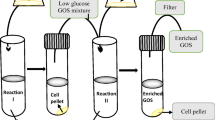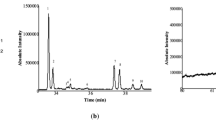Abstract
In the enzymatic synthesis of galacto-oligosaccharide (GOS), the primary by-products include glucose, galactose and unreacted lactose. This This study was aimed to provide a method to to purify GOS by yeat fermentation and explore the interaction between GOS and CAS with a view for expanding the prospects of GOS application in the food industry. The crude GOS(25.70 g/L) was purified in this study using the fermentation method with Kluyveromyces lactis CICC 1773. Optimal conditions for purification with the yeast were 75 g/L of the yeast inoculation rate and 50 g/L of the initial crude GOS concentration for 12 h of incubation. After removing ethanol produced by yeast by low-temperature distillation, GOS content could reach 90.17%. A study of the interaction between GOS and casein (CAS) in a simulated acidic fermentation system by D-(+)-gluconic acid δ-lactone (GDL) showed that the GOS/CAS complexes with higher GOS concentrations, e.g., 4% and 6% (w/v), was more viscoelastic with higher water-holding capacity, but decreased hardness, elasticity, and cohesiveness at 6% (w/v) of GOS. The addition of GOS to CAS suspension significantly caused (p<0.05) decreased particle sizes of the formed GOS/CAS complexes, and the suspension system became more stable. FT-IR spectra confirmed the existence of different forms of molecular interactions between CAS and GOS, e.g., hydrogen bonding and hydrophobic interaction, and the change of secondary structure after CAS binding to GOS.



Similar content being viewed by others
Data Availability
The data generated in this research work has been included in this manuscript.
References
Boehm G, Lidestri M, Casetta P, Jelinek J, Negretti F, Stahl B, Marini A (2002) Supplementation of a bovine milk formula with an oligosaccharide mixture increases counts of faecal bifidobacteria in preterm infants. Arch Dis Child Fetal Neonatal Ed 86(3):F178–F181. https://doi.org/10.1136/fn.86.3.f178
Caohong X, Wang J, Yang X, Yu S (2018) Effects of glycosylation methods on conformation and functional properties of glycosylation products for soybean 7S globulin. Sci Technol Food Ind 39(3):52–5560. https://doi.org/10.13386/j.issn1002-0306.2018.03.011
Cheng CC, Yu MC, Cheng TC, Sheu DC, Duan KJ, Tai WL (2006) Production of high-content galacto-oligosaccharide by enzyme catalysis and fermentation with Kluyveromyces marxianus. Biotechnol Lett 28(11):793–797. https://doi.org/10.1007/s10529-006-9002-1
Ding L, Huang Y, Cai X, Wang S (2019) Impact of pH, ionic strength and chitosan charge density on chitosan/casein complexation and phase behavior. Carbohydr Polym. 2019, 15;208:133–141. https://doi.org/10.1016/j.carbpol.2018.12.015
Du B, Li J, Zhang H, Chen P, Huang L, Zhou J (2007) The stabilization mechanism of acidified milk drinks induced by carboxymethylcellulose. Le Lait 87(4–5):287–300. https://doi.org/ffhal00895650f
Fischer C, Kleinschmidt T (2018) Synthesis of galactooligosaccharides in milk and whey: a review. Compr Rev Food Sci Food Saf 17(3):678–697. https://doi.org/10.1111/1541-4337.12344
Flakus HT, Hachuła B. Effect of the resonance of the C-H and O-H bond stretching vibrations on the IR spectra of the hydrogen bond in formic and acetic acid. Spectrochim Acta A Mol Biomol Spectrosc 2011;79(5):1276–84. https://doi.org/10.1016/j.saa.2011.04.054
Foroutanparsa S, Brüls M, Maljaars CEP, Tas RP, Voets IK (2023) Spatial distribution of αs1-caseins and β-caseins in milk gels acidified with glucono-δ-lactone. Food Hydrocoll 139:108506. https://doi.org/10.1016/j.foodhyd.2023.108506
Ge Z, Yin D, Li Z, Chen X, Dong M (2022) Effects of Commercial Polysaccharides Stabilizers with Different Charges on Textural, Rheological, and Microstructural Characteristics of Set Yoghurts. Foods.; 11(12):1764. https://doi.org/10.3390/foods11121764
Gong S, Yang C, Zhang J, Ying Y, Xinzhe G, Wenhui L, Zhengwu W (2021) Study on the interaction mechanism of purple potato anthocyanins with casein and whey protein. Food Hydrocolloids 111:106223. https://doi.org/10.1016/j.foodhyd.2020.106223
González-Cataño F, Tovar-Castro L, Castaño-Tostado E, Regalado-Gonzalez C, García-Almendarez B, Cardador-Martínez A, Amaya-Llano S (2017) Improvement of covalent immobilization procedure of β-galactosidase from Kluyveromyces lactis for galactooligosaccharides production: modeling and kinetic study. Biotechnol Prog 33(6):1568–1578. https://doi.org/10.1002/btpr.2509
Guerrero C, Carlos V, Catalina N, Jorge D, Fernando A, Andrés I (2014) Purification of highly concentrated galacto-oligosaccharide preparations by selective fermentation with yeasts. Int Dairy J 39(1):78–88. https://doi.org/10.1016/j.idairyj.2014.05.011
Gulay B, Ayse GC, Yakup MA (2023) Immobilisation of β-galactosidase onto double layered hydrophilic polymer coated magnetic nanoparticles: Preparation, characterisation and lactose hydrolysis. Int Dairy J 138:105545. https://doi.org/10.1016/j.idairyj.2022.105545
Gyawali R, Ibrahim SA (2016) Effects of hydrocolloids and processing conditions on acid whey production with reference to greek yogurt. Trends Food Sci & Tech 56:61–76. https://doi.org/10.1016/j.tifs.2016.07.013
He W, Mu H, Liu Z, Lu M, Hang F, Chen J, Zeng M, Qin F, He Z (2018) Effect of preheat treatment of milk proteins on their interactions with cyanidin-3-O-glucoside. Food Res Int 107:394–405. https://doi.org/10.1016/j.foodres.2018.02.064
Hua Z, Urooj A, Qingxia R, Mengke Y, Tiantian L, Sumaira N, Tariq A, Manal YS, Min Z, Zhennai Y (2023) Integrated metabolomic analysis of lactiplantibacillus plantarum NMGL2 reveals its survival and response to combinational cold and acidic conditions during storage of fermented milk. Food Bioscience 54:102833. https://doi.org/10.1016/j.fbio.2023.102833
Li Z, Xiao M, Lu L, Li Y (2008) Production of non-monosaccharide and high-purity galactooligosaccharides by immobilized enzyme catalysis and fermentation with immobilized yeast cells. Process Biochem 43(8):896–899. https://doi.org/10.1016/j.procbio.2008.04.016
Liu Y, Xie MX, Kang J, Zheng D (2003) Studies on the interaction of total saponins of panax notoginseng and human serum albumin by Fourier transform infrared spectroscopy. Spectrochim Acta A Mol Biomol Spectrosc 59(12):2747–2758. https://doi.org/10.1016/s1386-1425(03)00055-6
Maráz A, Kovács Z, Benjamins E, Pázmándi M (2022) Recent developments in microbial production of high-purity galacto-oligosaccharides. World J Microbiol Biotechnol 20(6):95. https://doi.org/10.1007/s11274-022-03279-4
Kim, J., Watkinson, P., Lad, M. Merino ML, Jeremy RS, Matt G. (2022) Effect of process and formulation variables on the Structural and Physical Properties in cream cheese using GDL Acidulant. Food Biophys 17:273–287. https://doi.org/10.1007/s11483-022-09719-w. Jeremy RS
Mei Z, Yuan J, Li D (2022) Biological activity of galacto-oligosaccharides: a review. Front Microbiol 6:13:993052. https://doi.org/10.3389/fmicb.2022.993052
Meletharayil GH, Patel HA, Metzger LE, Huppertz T (2016) Acid gelation of reconstituted milk protein concentrate suspensions: Influence of lactose addition. Int Dairy J, 2016, 61,107–113. https://doi.org/10.1016/j.idairyj.2016.04.005
Naiim M, Boualem A C, Ferre M, Jabloun A, Jalocha P, Ravier (2015) Multiangle dynamic light scattering for the improvement of multimodal particle size distribution measurements. Soft Matter 11(1). https://doi.org/10.1039/C4SM01995D
Nishinari K, Fang Y, Guo S, Philips GO (2014) Soy proteins: a review on composition, aggregation and emulsification. Food Hydrocolloids 39:311–318. https://doi.org/10.1016/j.foodhyd.2014.01.013
Nöbel S, Protte K, Körzendörfer A, Bernd H, Jorg H (2016) Sonication induced particle formation in yogurt: influence of the dry matter content on the physical properties. J Food Eng 191:77–87. https://doi.org/10.1016/j.jfoodeng.2016.07.007
Pázmándi M, Kovács Z, Balga E, Kovács M, Maráz A (2020) Production of high-purity galacto-oligosaccharides by depleting glucose and lactose from galacto-oligosaccharide syrup with yeasts. Yeast 37(9–10):515–530. https://doi.org/10.1002/yea.3507
Rohart A, Michon C, Confiac J, Véronique B (2016) Evaluation of ready-to-use SMLS and DWS devices to study acid-induced milk gel changes and syneresis. Dairy Sci & Technol 96:459–475. https://doi.org/10.1007/s13594-016-0281-6
Saravanan R, Shubethar S, Narayanan S, Jain M, Lade S, Jadhav D, Maheswaran P, Avalakki UK, Dubey AK (2017) A novel process for the production of high-purity galactooligosaccharides (GOS) using consortium of microbes. Prep Biochem Biotechnol 16(3):245–253. https://doi.org/10.1080/10826068.2016.1207082
Sen D, Gosling A, Stevens GW, Bhattacharya PK, Barber AR, Kentish SE, Gras SL (2011) Galactosyl oligosaccharide purification by ethanol precipitation. Food Chem 128:773–777 https://doi.org/10.1016/j.foodchem.2011.03.076
Sun W, Yang W, Zheng Y, Zhang H, Fang H, Liu D, Kong X, Chen S, Ye X, Tian J (2020) Effect of Potato Pulp Pectic Polysaccharide on the Stability of acidified milk drinks. Molecules 25(23):5632. https://doi.org/10.3390/molecules25235632
Sun W, Zheng Y, Chen S, Chen J, Zhang H, Fang H, Ye XTian J (2021) Applications of Polysaccharides as Stabilizers in Acidified Milks. Food Rev in 601–617. https://doi.org/10.1080/87559129.2021.1923732
Tokošová S, Hronská H, Rosenberg M (2016) Production of high-content galacto-oligosaccharides mixture using β-galactosidase and Kluyveromyces marxianus entrapped in polyvinylalcohol gel. Chem Pap 70:1445–1451. https://doi.org/10.1515/chempap-2016-0081
Wang K, Duan F, Sun T, Zhang Y, Lu L (2023) Galactooligosaccharides: synthesis, metabolism, bioactivities, and food applications. Crit Rev Food Sci Nutr 12:1–17. https://doi.org/10.1080/10408398.2022.2164244
Wang Y, Li C, Liu P, Zaheer A, Ping XXiaojiao B (2010) Physical characterization of exopolysaccharide produced by Lactobacillus plantarum KF5 isolated from Tibet Kefir. Carbohydr Polym, 82(3), 895–903. https://doi.org/10.1016/j.carbpol.2010.06.013
Zhang M, Lai T, Yao M, Zhang M, Yang Z (2021a) Interaction of the Exopolysaccharide from Lactobacillus plantarum YW11 with casein and bioactivities of the Polymer Complex. Foods 10(6):1153. https://doi.org/10.3390/foods10061153
Zhang X, Yao C, Wang T, Zhao H, Zhang B (2021b) Production of high-purity galacto-oligosaccharides (GOS) by Lactobacillus-derived β-galactosidase. Eur Food Res Technol 247:1501–1510. https://doi.org/10.1007/s00217-021-03727-9
Zhang P, Tang F, Cai W, Zhao X, Shan C (2022) Evaluating the effect of lactic acid bacteria fermentation on quality, aroma, and metabolites of chickpea milk. Front Nutr 5:9:1069714. https://doi.org/10.3389/fnut.2022.1069714
Zhao L, Zhang S, Uluko H, Liu L, Lu J, Xue H, Kong F, Lv J (2014) Effect of ultrasound pretreatment on rennet-induced coagulation properties of goat’s milk. Food Chem 15:165:167–174. https://doi.org/10.1016/j.foodchem.2014.05.081
Zhiguo Z, Qinghai S, Shuo W (2013) Determination of average DP of galactooligosaccharides by Bi-Column HPLC. J Chin Inst Food Sci Technol 13:237–242. https://doi.org/10.16429/j.1009-7848.2013.12.020
Zhijian Y, Zhang M, Yao M, Zhao J, Chen C, Cao Y, Yang Z (2021) Effects of Skimmed milk powder with different Heat Treatment on Stability of Brown Lactobacillus Beverage. J Food Sci Technol 39(2):117–125. https://doi.org/10.12301/j.issn.2095-6002.2021.02.015
Acknowledgements
The authors greatly acknowledge and express their gratitude to the Researchers Supporting Project number (RSP2023R335), King Saud University, Riyadh, Saudi Arabia.
Funding
This research work was financially supported by National Natural Science Foundation of China (Project No. 2017YFE0131800).
Author information
Authors and Affiliations
Contributions
Author Contributions: Conceptualization, G.H, T.A, A.A.K, A.S, Z.M, and Y.Z; methodology, G.H, T.A, A.A.K, A.S, Z.M, and Y.Z; software, M.A; validation, A.A.S; formal analysis, T.A.; investigation, .A.F.A, M.N, K.J, M.A.S and Y.Z; resources, Y.Z; M.A and A.A.S.; data curation, T.A.; writing—original draft preparation, T.A and M.N.; writing—review and editing, T.A and M.N; visualization, A.A.S and M.A.S; supervision, Y.Z.; project administration, A.A.S and M.A; funding acquisition, Y.Z.
Corresponding author
Ethics declarations
Conflict of interest
The authors declare no conflict of interest.
Additional information
Publisher’s Note
Springer Nature remains neutral with regard to jurisdictional claims in published maps and institutional affiliations.
Rights and permissions
Springer Nature or its licensor (e.g. a society or other partner) holds exclusive rights to this article under a publishing agreement with the author(s) or other rightsholder(s); author self-archiving of the accepted manuscript version of this article is solely governed by the terms of such publishing agreement and applicable law.
About this article
Cite this article
LI, Z., Tian-tian, L., Aziz, T. et al. Purification of Galacto-oligosaccharide (GOS) by fermentation with Kluyveromyces lactis and Interaction between GOS and casein under simulated acidic fermentation conditions. World J Microbiol Biotechnol 39, 342 (2023). https://doi.org/10.1007/s11274-023-03791-1
Received:
Accepted:
Published:
DOI: https://doi.org/10.1007/s11274-023-03791-1




